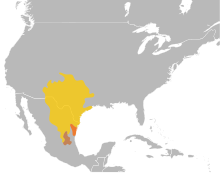Hypsiglena jani
| Hypsiglena jani | |
|---|---|

| |
| Scientific classification | |
| Domain: | Eukaryota |
| Kingdom: | Animalia |
| Phylum: | Chordata |
| Class: | Reptilia |
| Order: | Squamata |
| Suborder: | Serpentes |
| Family: | Colubridae |
| Genus: | Hypsiglena |
| Species: | H. jani
|
| Binomial name | |
| Hypsiglena jani (Dugès, 1865)
| |

| |
| The distribution of Hypsiglena jani (brown), which now includes the two former subspecies Hypsiglena torquata dunklei (orange), and Hypsiglena torquata texana (yellow). | |
| Synonyms | |
| |
Hypsiglena jani, commonly known as the Texas night snake or the Chihuahuan night snake, is a small species of mildly venomous snake in the family Colubridae. The species is native to the southwestern United States and adjacent northeastern Mexico.
Etymology
The epithet, jani, is in honor of Italian taxonomist Giorgio Jan.[8]
Description
H. jani grows from 10 to 16 inches (25 to 41 centimetres) in total length (including tail), record 20 inches (51 cm).
Behavior
As the common names imply, H. jani is a primarily
Diet
The diet of H. jani consists of primarily lizards, but it will also eat smaller snakes and occasionally soft bodied insects.
Habitat
H. jani prefers semi-arid
Reproduction
H. jani is an
Geographic range
H. jani ranges from southern Kansas to southern Colorado, and south throughout New Mexico, the western half of Texas to central Mexico.
Subspecies
Three
- Hypsiglena jani dunklei Taylor, 1938
- Hypsiglena jani jani (Dugès, 1865)
- Hypsiglena jani texana Stejneger, 1893
References
- ^ Hammerson, G.A. (2019). "Hypsiglena jani". IUCN Red List of Threatened Species. 2019: e.T90067384A90067431. Retrieved 2 December 2021.
- ^ a b c "Hypsiglena jani ". The Reptile Database. www.reptile-database.org.
- ^ Stejneger L, Barbour T (1917). A Check List of North American Amphibians and Reptiles. Cambridge, Massachusetts: Harvard University Press. 125 pp. (Hypsiglena ochrorhynchus texana, p. 93).
- ^ Taylor EH (1938). "On Mexican Snakes of the Genera Trimorphodon and Hypsiglena ". Univ. Kansas Sci. Bull. 25 (16): 357-383. (Hypsiglena torquata dunklei, new subspecies, pp. 374-375 + Plate XXXVII, figure 1).
- ^ Global Names Index. gni.globalnames.org.
- ^ a b Wright AH, Wright AA (1957). Handbook of Snakes of the United States and Canada. Ithaca and London: Comstock Publishing Associates, a division of Cornell University Press. 1,105 pp. (in 2 volumes) (Hypsiglena torquata texana, pp. 326-330, Figure 101 + Map 30 on p. 315).
- ^ Mulcahy DG (2007). "Molecular systematics of neotropical cat-eyed snakes: a test of the monophyly of Leptodeirini (Colubridae: Dipsadinae) with implications for character evolution and biogeography". Biol. J. Linnaean Society 92: 483-500. (Hypsiglena jani).
- ISBN 978-1-4214-0135-5. (Hypsiglena jani, p. 133).
- ISBN 0-395-19977-8(paperback). (Hypsiglena torquata texana, p. 217 + Plate 33 + Map 170).
Further reading
- Dugès A (1865). "Du Liophis janii". Mém. Acad. Sci. Lett. Montpellier 6: 32–33. (Liophis jani, new species). (in French).
- ISBN 978-0-544-12997-9. (Hypsiglena jani, pp. 409–410 + Plate 39).
- Stejneger L (1893). "Annotated List of the Reptiles and Batrachians Collected by the Death Valley Expedition in 1891, with Descriptions of New Species". North American Fauna 7: 159–228. (Hypsiglena texana, new species, p. 205).
- Tanner WW (1944). "A Taxonomic Study of the Genus Hypsiglena ". Great Basin Naturalist 5 (3 & 4): 25–92. (Hypsiglena dunklei, p. 48; H. ochrorhynchus janii, pp. 48–51; and H. o. texana, pp. 51–54).
External links
- Species Hypsiglena jani at The Reptile Database

